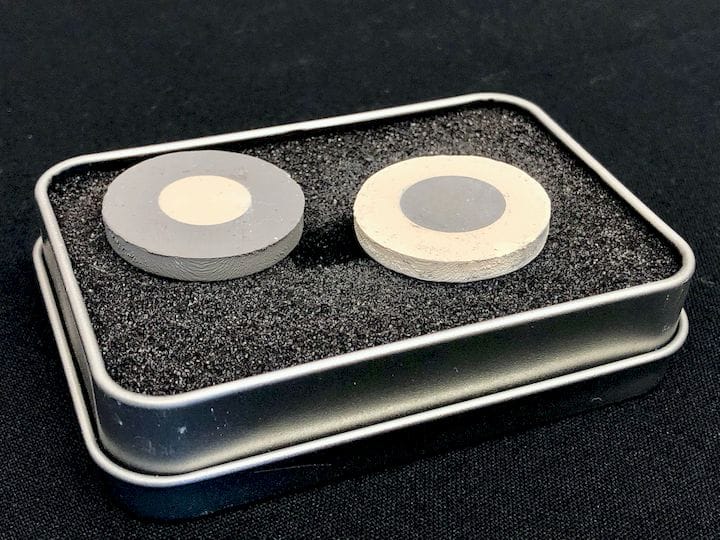![Steel and ceramic multimaterial 3D prints made by XJet [Source: Fabbaloo]](https://fabbaloo.com/wp-content/uploads/2020/05/image-asset_img_5eb096d81c7fa.jpg)
XJet has accomplished something we’ve never seen before: a combination metal and ceramic 3D print.
The Israel-based company has been developed a very unique 3D printing process involving liquid droplets containing nanoparticles of material. The nanoparticles can be made from a number of different materials, ranging from ceramics, to metals to even polymers. The droplets are selectively deposited by an inkjet-type mechanism, and the prints are post processed to remove the binder and form the final object. They call this process Nanoparticle Jetting, or “NPJ”.
Their original goal was to produce a powerful metal 3D printer, which they seem to be doing. But along the way they realized they could more quickly test the concept with ceramic materials. To their surprise, after announcing an initial ceramic 3D printer, they were besieged by customers making orders, and they’ve made a tidy business selling the ceramic capability.
But they continued working on the metal capability, and have achieved this capability as well. In fact, only two months ago they achieved a significant milestone by producing metal prints with zero porosity, and 100% metal. This is a critical achievement as it demonstrates the process could be used for production metal parts.
Similarly, they’ve achieved a 99.9% purity for zirconia (a ceramic) prints.
One extremely interesting experiment they’ve recently undertaken is to attempt a multimaterial print using the NPJ process. In the example imaged here, you can see a print with both steel and ceramic, made in a single print operation. I do not believe this has ever been done previously by anyone.
![Steel and ceramic multimaterial 3D prints made by XJet [Source: Fabbaloo]](https://fabbaloo.com/wp-content/uploads/2020/05/image-asset_img_5eb096d84a55e.jpg)
Note, however, that these samples are quite fragile as they have not undergone complete post-processing.
It’s a work in progress, however, as there are challenges to the post-processing steps. In the NPJ process, the “green” prints are heated to remove the binder and sinter the materials together.
The catch here is that the two materials have different sinter temperatures. How can you develop a furnace sintering process that can successfully sinter both materials? Would one material’s higher temperature requirement damage the other material? This sounds like a very tricky problem to solve, and it seems that XJet is on the case.
If XJet can complete their multimaterial process, one wonders what possible applications might be present. This is quite a stretch into the future, as many organizations are still learning how to design for additive manufacturing, as opposed to their previous training to design for traditional making machines.
I believe it is important for XJet to complete this project, as it could be one of the significant differentiations from their competitors. Most other metal and ceramic 3D printing processes utilize a powder bed approach, where the bed is composed of only a single material; it is seemingly impossible to do multimaterial powder-based 3D prints.
![More multimaterial 3D prints made by XJet [Source: Fabbaloo]](https://fabbaloo.com/wp-content/uploads/2020/05/image-asset_img_5eb096d876cfb.jpg)
Another factor to consider here is that XJet’s NPJ process can theoretically accommodate a far wider array of possible materials, well beyond the few ceramics and metals they are current working with. It’s possible we may see a future XJet device capable of 3D printing objects with a number of materials all at once, opening up some interesting possibilities.
Via XJet











Additive Flow has unveiled a new generative design tool for additive manufacturing that has the unique ability to handle solutions for materials and mechanical design simultaneously.